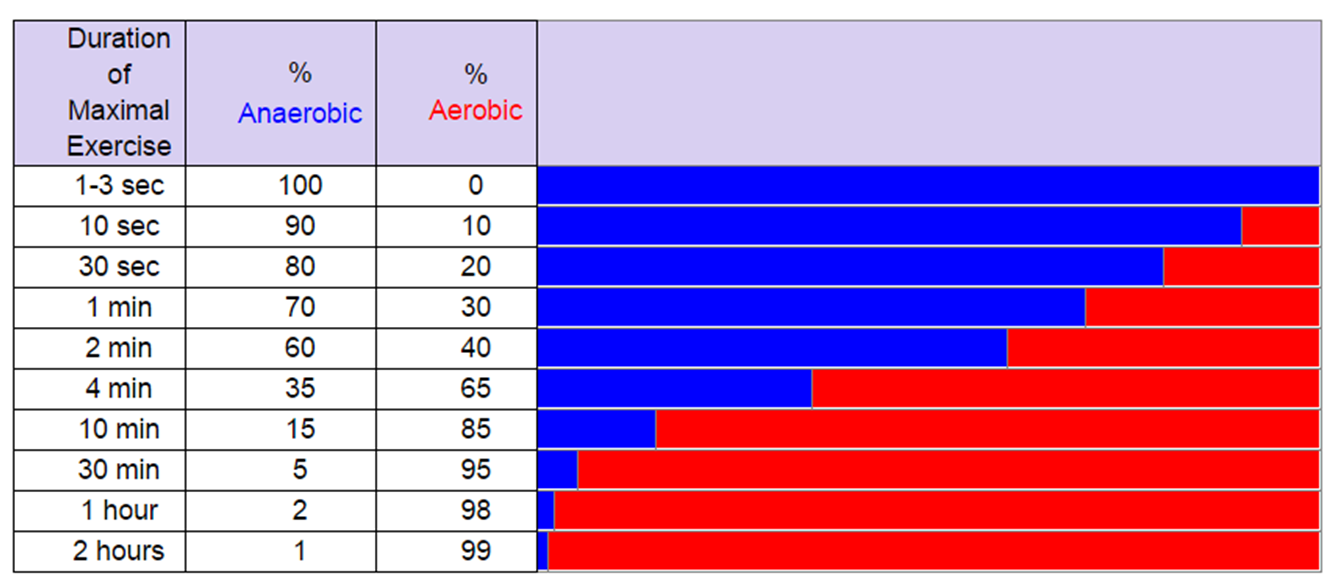This blog will explain Energy Systems and prepare you for your Anatomy and Physiology Test,
Plus TEN Mock Questions are mapped to your Level 2 and 3 exams.
You’ll discover:
- Why you need to know about Energy Systems as a FITPRO
- Characteristics of all three energy systems
- Energy Systems used in sport and exercise
- TEN Energy Systems Mock Questions and answers to test your knowledge
Why you need to know about Energy Systems as a FitPro
All movement requires energy. The methods by which the body generates energy are determined by the intensity and duration of the activity being undertaken.
Activities that require short bursts of effort, such as sprinting or jumping, require the body to produce large amounts of energy over a short period, whereas activities like marathon running or endurance cycling require continued energy production over a longer period and at a slower rate.
It is the energy systems of your body that facilitate these processes.
Energy is required in order to make the muscle fibres contract. This energy is obtained from the oxidation of foods in the diet, particularly carbohydrate and fat.
When these substances are burned in the muscle cells, Adenosine Triphosphate [ATP] is formed, which is rich in energy.
When ATP is broken down, it gives energy for muscle contraction. It is the only molecule that can supply the energy used in the contraction of muscle fibres and can be made in three ways:
- the creatine phosphate system which is also called Phosphocreatine,
- the lactic acid energy system
- and the aerobic energy system.
Prepare for your Anatomy and Physiology Test by reading the text below and then test your knowledge using the TEN energy systems mock questions at the bottom of this blog
How energy systems work:
The body’s ability to extract energy from food and transfer it to the contractile proteins in the muscles determines your capacity to exercise for different durations at differing intensities. Thousands of complex chemical reactions are responsible for this energy transfer. The body maintains a continuous supply of energy through the use of adenosine triphosphate (ATP), which is often referred to as the energy currency of the body.
ATP consists of a base (adenine) and three phosphate groups.
It is formed by a reaction between an adenosine diphosphate (ADP) molecule and a phosphate. ATP is a versatile molecule that can be used for many things. Energy is stored in the chemical bonds in the molecules.
When a bond is broken, energy is released.
but when a bond is made, energy is stored.
ADP binds another phosphate, energy is stored that can be used later. when a molecule of ATP is combined with water, the last group splits off and energy is released.
The energy systems of the body can function aerobically (with oxygen) or anaerobically (without oxygen.) Movements that require sudden bursts of effort are powered by anaerobic systems, whereas prolonged activities are aerobic.
Lets look into each in more detail
Creatine phosphate energy system
This energy system creates ATP quickly and without Oxygen, which means it acts like first gear in a car. However, it doesn’t last long before the fuel is used up.
Creatine phosphate system is associated to fast explosive movements and movements of high power or very high intensity anaerobic intervals.
ATP and creatine phosphate (or phosphocreatine, or PCr) make up the ATP-PCr system. it is the immediate energy system. Creatine phosphate (PCr) is a high-energy compound.
When exercise intensity is high, or energy needs are instantaneous, creatine phosphate stored in muscle is broken down to provide energy to make ATP. When the high-energy bond in PCr is broken, the energy it releases is used to resynthesize ATP.
In this process, ATP is usually made without the presence of oxygen. Explosive work can be achieved, but only for short periods (up to about 10 seconds) at maximum intensity, as the supply of PCr is very limited.
Lactic acid energy system
This is the short-term energy system. To meet energy requirements for higher intensity over a long period, such as during a 400-metre race, ATP can be made by the partial breakdown of glucose and glycogen.
This is an anaerobic process (it does not include oxygen) and therefore is not sustainable over a long duration. Around 1 – 3 mins of maximal work are possible using this system.
Anaerobic glycolysis
When the ATP-PCr system begins to fade at around 10 seconds, the process of anaerobic glycolysis begins to occur.
This system breaks down liver and muscle glycogen stores without the presence of oxygen, which produces lactic acid as a by-product. This limits energy production via this process.
Lactic acid production
Lactic acid is the limiting factor of the anaerobic system. It accumulates and diffuses into the tissue fluid and blood. if this substance is not removed by the circulatory system, it builds up to impede muscle contraction and cause fatigue. You may have experienced this during intense exercise as an uncomfortable burning sensation in your muscles.
Aerobic Energy system
This is the long-term energy system and is guaranteed to feature in your Anatomy and Physiology Test.
If plenty of oxygen is available, as it is during everyday movements and light exercise, glycogen and fatty acids break down to yield large amounts of ATP. This produces carbon dioxide and water, which do not affect the muscles’ ability to contract.
Aerobic energy production occurs in the mitochondria (mitochondria – organelles enzymes responsible for energy production. Mitochondria are therefore the part of a muscle responsible for aerobic energy production.) of the cells. these are the power stations of the cells, responsible for converting the food ingested by the cells into energy.
The production of energy within the aerobic system is slow to engage because it takes a few minutes for the heart to deliver oxygenated blood to working muscles. Long, continuous and moderate exercise produces energy using this system.
Energy Systems Used in Sport and Exercise
The three energy systems do not work independently of one another. From very short, very intense exercise, to very light, prolonged activity, all three energy systems make a contribution however, one or two will usually predominate.
Two factors of any activity carried out affect energy systems more than any other variable they are the intensity and duration of exercise.
This table shows the effect of just duration on the proportion of Aerobic / Anaerobic Production of Energy (ATP).

Examples of DOMINANT energy systems in sports and exercise types:
Boxing = with 3 min rounds this predominantly uses Lactic Acid System
Marathon Running = endurance is the main focus therefore aerobic energy system is dominant
Football = Depending on the position played. A goal keeper may use more Creatine phosphate system based on explosive movements. A mid-fielder may be more aerobic energy system with lactic acid system as a close second
Power lifting = The competitive lifts are under 10 secs and very explosive, therefore it would be mostly creatine phosphate system
Got questions about your revision, or want more mock questions: MESSAGE US HERE
In summary
- The Creatine Phosphate System lasts 10 secs or less and is used for anaerobic explosive activity
- Lactic Acid System lasts between 10 secs and 3 mins and is used for anaerobic middle-duration activites at a high intensity
- The Aerobic System is where we spend most of our time, lasts for an infinite amount of time and is used for aerobic light-moderate intensity exercise
- Check out the TEN Mock Questions Below to check your knowledge
- Here’s what Lydia had to say about the A&P Revision Bootcamp
I can’t recommend Parallel Coaching enough their learning material is fantastic and definitely was a huge factor in me passing my A&P level 3!
Lydia
Prepare for your anatomy and physiology test with TEN Energy Systems Mock Questions
Look at the TEN Energy Systems Mock Questions below and jot down your answer on a scrap paper or as a note on your phone.
Then scroll down to reveal the answers.
Q1. Which Energy System would be dominant in an olympic 400m Running race?
A. Aerobic
B. Lactic Acid
C. Creatine Phosphate
D. ATP
Q2. What does ATP stand for?
A. Aerobic Trial phosphate
B. Aerobic Triphosphate
C. Adenosine Triphosphate
D. Adenosine Diphosphate
Q3. Which energy system uses fat as a fuel source?
A. Creatine Phosphate
B. Lactic Acid
C. Anaerobic
D. Aerobic
Q4. What is the name of the organelle used for the production of aerobic energy ?
A. Mitochondria
B. Capillaries
C. Nucleus
D. Glycogen
Q5. Which energy system yields the greatest amount of ATP?
A. Aerobic
B. Lactic Acid
C. Creatine Phosphate
D. ATP
Q6. What is the maximum time duration of the Lactic Acid Energy System?
A. 3 secs
B. 10 secs
C. 3 minutes
D. 10 minutes
Q7. What by-product of energy production can impede performance?
A. Oxygen
B. Lactic Acid
C. Carbon dioxide
D. Water
Q8. When is the energy released from a molecule of ATP ?
A. When a bond is broken
B. When a bond is created
C. When energy is stored
D. When ADP becomes ATP
Q9. When would anaerobic energy production be required?
A. When intenisty is lower than the availablility of carbondioxide
B. When intenisty is lower than the availablility of oxygen
C. When intenisty is higher than the availablility of carbondioxide
D. When intenisty is higher than the availablility of oxygen
Q10. Which of the following would predominantly use the Lactic Acid System?
A. Boxing
B. Marathon Running
C. Powerlifting
D. 1 mile swim
Got questions about your revision: MESSAGE US HERE
Answers:
Q1: = B
Q2: = C
Q3: = D
Q4: = A
Q5: = A
Q6: = C
Q7: = B
Q8: = A
Q9: = D
Q10 = A
If you want more mock questions like this, then you can download more Free Mock Questions: DOWNLOAD NOW
Need More Help with your Level 3 Anatomy Revision?
For Trainee FITPROS Taking Their L3 Anatomy & Physiology Exam.
Learn, Revise & Pass Your Level 3 Anatomy & Physiology Exam In Under 10-hours
(Without Having To Spend Hours Revising Or Feeling Overwhelmed)
If you want to get your revision structured, learn everything you need to know, and feel confident on exam day, then click the link below:

Dedicated to More
Hayley “Anatomy and Physiology Test” Bergman
Parallel Coaching
P.S. You can also find us on the following platforms:
Instagram: Follow Now
Facebook: Like Our Page
Twitter: Tweet Us
YouTube: Subscribe Here
More Energy Systems Revision Blogs: HERE


fair enough